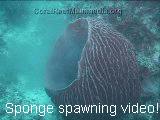
 The Sponge Barcoding Project https://www.spongebarcoding.org/ aims to barcode all described sponges, about 8,000 species in the phylum Porifera. The initial phase of 3 years will focus on 2,000 species covering all genera.
The Sponge Barcoding Project https://www.spongebarcoding.org/ aims to barcode all described sponges, about 8,000 species in the phylum Porifera. The initial phase of 3 years will focus on 2,000 species covering all genera.
Sponges are thought to be the earliest living branch on the multicellular animal tree and are difficult even for experts to identify. In addition to their ecological importance, sponges are sources for novel pharmaceuticals and biomaterials (eg Sipkema et al 2005 Biotech Bioengineer 90:201).
Like some corals, some sponges show very few differences in mitochondrial DNA with the standard COI barcode (corals, Shearer et al 2002 Mol Ecol 11: 2475; sponges, Erpenbeck et al 2006 Mol Ecol Notes 6: 550). The latter study suggests that the 3′ end of COI may provide greater resolution for Porifera and Cnidaria. An important goal of the initial phase of the project is to determine the best strategy for obtaining species-level identifications, one that provides sufficient resolution to separate most of the closely-related species and still takes advantage as much as possible of the benefits of standardization on 5′ COI.
I note that in animals closely related sister species are often largely or completely allopatric. In such cases, combining genetic barcode data with GIS coordinates may improve the certainty of some identifications.
For fun, I close with a sponge video:
